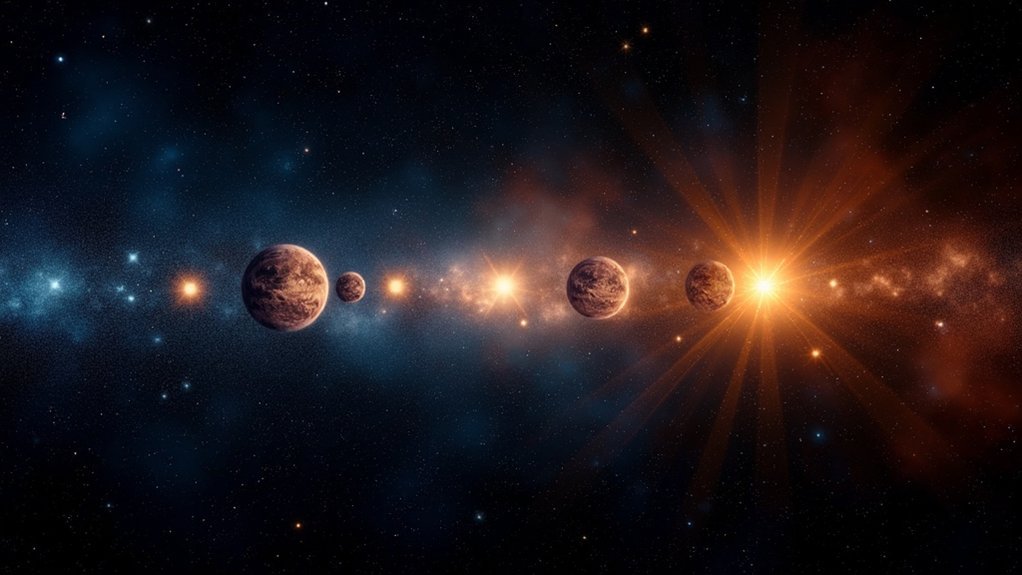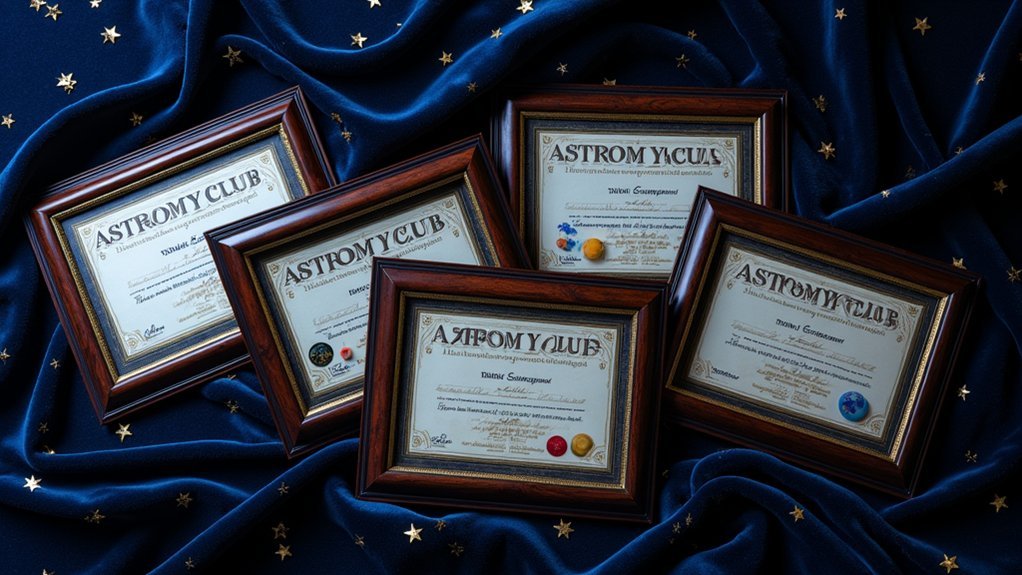Stars are classified by spectral type based on temperature and color. O-type stars burn hottest (30,000-50,000K) but live briefly, while red M-dwarfs (2,400-3,700K) can survive trillions of years. Our Sun is a G-type star with moderate temperature and lifespan. Other categories include blue B-stars, white A-stars, yellow F-stars, orange K-stars, and failed stars like brown dwarfs. Each classification reveals fascinating details about a star’s life, death and cosmic significance.
O-Type Stars: The Hottest and Shortest-Lived Giants

At the pinnacle of stellar classification, O-type stars reign as cosmic behemoths with surface temperatures soaring between 30,000 and 50,000 Kelvin.
These rare blue giants constitute merely 0.00003% of all stars but shine with extraordinary luminosity—up to one million times brighter than our Sun.
O-type stars—stellar titans of unimaginable brilliance, outshining our Sun a million-fold despite their cosmic rarity.
You’ll find these stellar giants in regions of recent star formation, often within nebulae and star clusters.
Despite their massive size (15-90 solar masses), they’re surprisingly compact with radii only about 10 times that of our Sun.
Don’t expect O-type stars to stick around long—their voracious energy consumption limits their main sequence lifetimes to just 1-10 million years.
Their powerful stellar winds, reaching speeds of 2,000 km/s, continually strip away their outer layers.
Notable examples like ζ Ophiuchi and μ Columbae are classified as runaway stars due to their high velocity through space.
B-Type Stars: Brilliant Blue Powerhouses
One step down from the scorching O-type stars, B-type stars represent the second hottest classification in stellar hierarchy. You’ll recognize these blue giants by their brilliant blue hues, radiating at temperatures between 10,000-25,000 K. Despite their rarity (only 1 in 800 stars near us), they’re powerhouses with luminosities about a million times that of our Sun. These stars are characterized by their strong neutral helium lines which are important distinguishing features in the Harvard classification system.
| Characteristic | Description | Example |
|---|---|---|
| Lifespan | 5-100 million years | Extremely brief compared to Sun’s 10 billion years |
| Spectral Features | Neutral helium lines, moderate hydrogen | Strongest helium in B2 subclass |
| Common Subtypes | Be stars, B[e] stars, Blue supergiants | Regulus (B7, 80 light-years away) |
| Location | OB associations, spiral arms | Found in young star-forming regions |
| Evolution | Main sequence → Blue supergiant → Supernova | Often skip intermediate evolutionary stages |
A-Type Stars: White-Hot Stellar Beacons

A-Type stars shine with remarkable white-hot intensity, boasting temperatures between 7,400-10,000 Kelvin and luminosities up to 40 times brighter than our Sun.
You’ll recognize famous examples like Sirius A (the brightest star in our night sky), Vega, and Altair, each showcasing the characteristic blue-white appearance of this stellar class.
Spectral analysis of these stars reveals prominent hydrogen lines in their absorption spectra, which serves as a key identifier for astronomers.
Despite their brilliance, these stars live relatively short lives—only about a quarter the lifespan of our Sun—as they quickly burn through their hydrogen fuel before evolving into red giants and eventually white dwarfs.
Temperature and Luminosity Range
These stellar beacons shine with remarkable intensity, boasting surface temperatures between 7,600 K and 10,000 K that place them among the hotter main-sequence stars.
You’ll recognize A-type stars by their bluish-white appearance in the night sky, a direct result of their elevated temperatures. A-type stars exhibit the strongest hydrogen lines among all spectral types, making them crucial reference points for stellar classification.
When you study these stellar powerhouses, you’ll find their luminosity typically ranges from 5 to 25 times that of our Sun. This impressive brightness comes from:
- Masses between 1.4 and 2.1 times that of our Sun
- Radii approximately 1.4 to 1.8 times solar size
- Strong hydrogen Balmer absorption lines in their spectra
- Higher mass correlating directly with increased luminosity
Despite representing just 0.61% of main-sequence stars, A-type stars’ exceptional brightness makes them visible across vast cosmic distances.
Famous A-Type Examples
Among the celestial array of A-type stars, several standout examples have become familiar reference points for both amateur and professional astronomers.
You’ll immediately recognize Sirius, the brightest star in our night sky, as an A-type main-sequence star. Altair, another prominent A-type star, is remarkable for its rapid rotation, while Deneb serves as a magnificent example of an A-type supergiant.
These white-hot stellar beacons, with surface temperatures between A-type stars typically have relatively short lifespans compared to our Sun, as their higher masses cause them to burn through their hydrogen fuel more rapidly. 7,400K and 10,000K, are prized for their distinctive hydrogen spectral lines.
Though less common than cooler stars, their brightness makes them easily observable. You’ll find many A-type stars in binary systems and star-forming regions.
Their high masses and rotational velocities make them valuable subjects for studying stellar evolution, atmospheric composition, and internal dynamics.
Lifespan and Evolution
Despite their dazzling luminosity in our night sky, A-type stars lead remarkably brief lives by cosmic standards. These stellar beacons, weighing between 1.4-2.1 solar masses, burn through their hydrogen fuel much faster than our Sun, living only hundreds of millions of years rather than billions.
When you observe an A-type star, you’re witnessing a cosmic timeline that includes:
- A pre-main-sequence phase until hydrostatic equilibrium is achieved
- Main sequence hydrogen fusion without significant convective zones
- Evolution into cooler giants without experiencing a helium flash
- Final transformation into white dwarfs after shedding outer layers
Their relatively short lifespans explain why A-type stars are comparatively rare, though their contributions to the interstellar medium—enriching it with heavier elements—remain essential for future planetary system formation. Unlike red dwarfs that can exist for trillions of years on the main sequence, A-type stars rapidly progress through their life cycles due to their higher mass classification.
F-Type Stars: The Bridge Between Hot and Medium Stars

F-Type stars represent a fascinating shift in stellar classification, occupying the middle ground between scorching hot blue stars and moderate yellow stars like our Sun.
With surface temperatures of 6200-7200K, they appear yellow-white to blue-white and make up just 3% of main sequence stars in our neighborhood.
These stars are slightly larger than our Sun, with 1.2-1.6 solar masses and radii. Their spectral features prominently show neutral hydrogen lines that help astronomers identify and classify them.
Despite their impressive luminosity (1.4-5.1 times the Sun’s), they burn through fuel inefficiently, living only 4-9 billion years.
You’ll find F-Type stars like Polaris and Procyon A particularly interesting for exoplanet hunting, as their habitable zones could potentially support life, though they’d be farther from the star than Earth is from the Sun.
G-Type Stars: Our Sun’s Stellar Family
G-type stars, including our Sun, represent prime candidates for harboring life with their moderate 10-billion-year lifespans and stable energy output.
You’ll find these yellow stars scattered throughout our galaxy, making up about 7.5% of main-sequence stars in our cosmic neighborhood.
Their surface temperatures range between 5,300-6,000K, creating goldilocks zones around them where liquid water—and potentially life—can thrive on orbiting planets.
Like our Sun, which is a G2V type, G-type stars are classified as main sequence stars on the Hertzsprung-Russell Diagram, where they convert hydrogen to helium through nuclear fusion.
Our Cosmic Home
When you gaze at our Sun, you’re observing the archetypal member of the cosmic family known as G-type stars. These stellar cousins make up about 7.5% of main-sequence stars in our neighborhood, striking a perfect balance between longevity and energy output.
G-type stars are often considered sweet spots for potential life, thanks to:
- Stable lifespans of 9-18 billion years, providing ample time for evolution
- Moderate temperatures between 5,300-6,000 K, supporting liquid water zones
- Manageable radiation levels compared to hotter star classes
- Consistent energy output with fewer violent flares than smaller stars
Though colloquially called “yellow dwarfs,” you’d actually perceive G-type stars as white if viewed outside Earth’s atmosphere—our atmosphere creates the yellowish tint we associate with sunshine. Our sun is currently halfway through its lifecycle, having spent approximately 4.5 billion years fusing hydrogen into helium in its core.
Habitable Stellar Neighbors
Beyond our own Sun lies a fascinating collection of stellar siblings scattered throughout our cosmic neighborhood. These G-type stars, with their yellowish hue and temperatures between 5,300-6,000K, create ideal conditions for life to potentially emerge.
You’ll find these stellar cousins make up about 7.5% of main-sequence stars near us. Their stability is their greatest asset—burning hydrogen steadily for up to 10 billion years. This longevity provides planetary systems ample time to develop complex life forms. With lifespans ranging from 9 to 18 billion years, these stars offer extraordinarily long windows for evolutionary processes to unfold.
Notable members include Alpha Centauri and Tau Ceti, both subjects of intense scientific interest. The planets orbiting these stars within the habitable zone can maintain liquid water, creating environments where diverse biospheres might flourish—much like our own Earth circling its G2V star.
Medium-Life Yellow Stars
Our Sun represents the archetypal member of G-type stars, a stellar classification that defines medium-lived yellow stars scattered throughout the galaxy.
These main-sequence stars comprise about 7.5% of all stars in the Milky Way, offering stable conditions potentially suitable for life.
When you study G-type stars, you’ll discover they:
- Have surface temperatures between 5,300-6,000 Kelvin
- Maintain main-sequence lifespans of approximately 10 billion years
- Possess masses ranging from 0.8-1.04 times our Sun
- Feature prominent metallic spectral lines with weak hydrogen signatures
Notable examples beyond our Sun include Alpha Centauri A and Tau Ceti.
Their balanced radiation output and extended stability create ideal habitable zones, making them prime candidates in the search for extraterrestrial life. These stars will likely evolve into red giants after depleting their hydrogen fuel reserves, marking a dramatic transformation in their stellar lifecycle.
K-Type Stars: Orange Dwarfs With Extended Lifespans
While often overshadowed by their brighter G-type cousins like our Sun, K-type stars represent some of the most promising stellar candidates for harboring life in our galaxy. These orange-colored main sequence stars operate at temperatures between 3,900 and 5,300 Kelvin.
K-type stars may hold the greatest potential for nurturing alien life, despite living in the shadow of Sun-like stars.
You’ll find K-type stars living extraordinarily long lives, remaining stable for 17-70 billion years. They’re 3-4 times more abundant than Sun-like stars, making them excellent targets for exoplanet searches. Their moderate UV output and stable brightness create favorable conditions for potential life development.
Notable examples include Alpha Centauri B and Epsilon Eridani, which emit 10-50% of the Sun’s brightness. These stars are often classified with the luminosity class V designation in stellar classification systems.
Planets orbiting K-type stars enjoy wider habitable zones than those around red dwarfs, though they must orbit closer than Earth does to our Sun.
M-Type Stars: The Universe’s Most Common Red Dwarfs
M-type stars dominate our cosmic neighborhood, constituting a staggering 76% of all main-sequence stars in the universe.
These cool red dwarfs have surface temperatures between 2,400-3,700K, appearing distinctly red due to prominent titanium dioxide and vanadium monoxide in their spectra.
You’ll find these stars fascinating for four key reasons:
- They’re incredibly long-lived, potentially burning for trillions of years
- They’re small but mighty, with masses 0.075-0.5 times our Sun
- Stars below 0.35 solar masses are fully convective, maintaining constant luminosity
- Despite their abundance, their low luminosity makes them difficult to observe without telescopes
Proxima Centauri, our nearest stellar neighbor, exemplifies this common yet elusive stellar class. These stars burn hydrogen extremely slowly due to their efficient energy consumption, allowing them to remain on the main sequence far longer than other star types.
Wolf-Rayet Stars: Massive Stars Nearing Spectacular Death
Stellar infernos of unimaginable power, Wolf-Rayet stars represent some of the most extreme objects in our universe. Discovered in the 19th century by Wolf and Rayet, these massive stars (10-200 solar masses) are in their final evolutionary stages before going supernova. You’ll recognize them by their intense heat (up to 210,000 K) and powerful stellar winds expelling material at 3,000 km/s. These remarkable stars continually shed mass through radiation pressure, creating expanding nebulous envelopes around them.
| Type | Key Features | Typical End |
|---|---|---|
| WN | Nitrogen-rich spectra | Type Ib supernova |
| WC | Carbon-rich spectra | Type Ic supernova |
| WO | Oxygen-rich (rare) | Most violent explosions |
Despite their brilliance—sometimes exceeding a million solar luminosities—these stars remain challenging to observe, with only about 220 confirmed in our galaxy. Their short lifespans and spectacular deaths contribute considerably to cosmic element enrichment.
Brown Dwarfs: Failed Stars and Cosmic Misfits
Brown dwarfs occupy the cosmic no-man’s-land between planets and stars, with masses 13-80 times that of Jupiter—too massive to be planets but too light to sustain hydrogen fusion.
You’ll find these “failed stars” displaying a range of surface temperatures from 300K to 2,800K, which influences their appearance from magenta and orange to nearly black.
These temperature variations lead astronomers to classify brown dwarfs into spectral types M, L, T, and Y, creating a systematic way to understand these fascinating cosmic misfits.
Unlike proper stars, brown dwarfs form through the gravitational collapse of interstellar gas clouds but lack sufficient mass to ignite sustainable nuclear reactions.
DEFINING COSMIC FAILURES
Despite their celestial ambitions, brown dwarfs occupy a curious middle ground in our cosmic hierarchy—too massive to qualify as planets yet lacking sufficient mass to ignite the sustained hydrogen fusion that defines true stars.
You’ll recognize these cosmic misfits falling between 13-80 Jupiter masses, producing energy through brief deuterium fusion before cooling throughout their lives. Surface temperatures range from deep red to magenta, depending on their mass and age.
Unlike their more successful stellar siblings, brown dwarfs:
- Can’t sustain hydrogen fusion, relying on gravitational contraction for energy
- Appear reddish or magenta rather than truly brown despite their name
- Create their own light (unlike planets), though considerably dimmer than stars
- Retain lithium in their atmospheres, which stars completely destroy through fusion
These fascinating objects serve as essential links between planetary and stellar physics, helping you understand the spectrum of celestial bodies.
TEMPERATURE AND PROPERTIES
While occupying their liminal cosmic status, these failed stars exhibit fascinating physical characteristics that defy simple categorization. Brown dwarfs maintain Jupiter-like radii despite masses ranging from 5 to 80 times Jupiter’s, with temperatures spanning from 2200K down to a frigid 300K.
You’ll find them classified into M, L, T, and Y spectral types based on decreasing temperature. As they age, brown dwarfs cool rapidly from the T Tauri stage at approximately 3000K down to T dwarf temperatures, essentially cooling like a rock without sustained fusion. Their radius remains surprisingly constant due to electron degeneracy.
Most emit primarily infrared radiation, making detection challenging without specialized equipment. Their atmospheric composition reveals a complex chemistry that evolves with temperature—from dust clouds in warmer L dwarfs to methane-rich T dwarfs and ammonia-bearing Y dwarfs.
This cosmic evolution creates distinctive weather patterns and atmospheric phenomena unlike anything in our solar system.
White Dwarfs: The Dense Remnants of Stellar Evolution
White dwarfs represent one of the most fascinating endpoints in stellar evolution.
These incredibly dense stellar corpses form when stars like our Sun exhaust their nuclear fuel and shed their outer layers. Despite having masses comparable to the Sun, they’re compressed to Earth-sized diameters, resulting in densities over 100,000 times that of our star.
What makes white dwarfs remarkable:
- They’re incredibly common – over 97% of all stars in our galaxy will eventually become white dwarfs
- They cool extremely slowly, taking billions of years to fade completely
- Their cores consist primarily of carbon and oxygen in a crystallized state
- They’re stellar fossils that provide valuable insights into the life cycles of stars
Ultra-massive white dwarfs typically have cores composed primarily of oxygen and neon rather than carbon and oxygen.
Frequently Asked Questions
How Do Astronomers Measure a Star’s Spectral Classification From Earth?
You’ll measure a star’s spectral classification by analyzing its light through spectroscopy, examining absorption lines, and comparing these patterns with standard types. You’ll also use color filters to determine temperature characteristics.
Can Stars Change Their Classification Type During Their Lifetime?
Yes, stars can change their classification type during their lifetime. You’ll observe this when they exhaust core hydrogen, expand into red giants, or undergo other evolutionary changes that alter their temperature and luminosity.
How Does Metallicity Affect Star Classification and Characteristics?
Metallicity affects your star’s classification by influencing its temperature, size, and spectral lines. You’ll find higher metallicity stars appear redder and cooler, while lower metallicity stars are bluer, hotter, and show fewer metal absorption lines.
What Instruments Are Used to Determine Stellar Temperature Accurately?
You’ll find scientists determine stellar temperatures using spectrographs like SPIRou, HARPS, and NIRPS. They’ve also employed space telescopes like Hubble and James Webb, utilizing high-resolution spectroscopy to detect temperature variations down to fractions of degrees.
How Does Binary Star Status Impact Classification of Component Stars?
In binary systems, you’ll find that mass transfer and stellar interactions alter spectral features, distort luminosity measurements, and complicate temperature determinations, making accurate classification of individual component stars challenging without specialized analysis techniques.
In Summary
You’ve now explored the diverse family of stars that populate our universe. From scorching O-types to cool M-dwarfs, each classification tells a unique cosmic story. Whether looking at massive Wolf-Rayets, failed Brown Dwarfs, or dense White Dwarfs, you’ll find fascinating variations in temperature, size, lifespan, and destiny. Next time you gaze upward, you’ll appreciate these distant suns with newfound understanding.





Leave a Reply